Gone huntin'
“Eyes on the side like to hide. Eyes on the front like to hunt.” With rhymes like these, we begin to introduce students to the energy relationships between prey and predator here in the North Cascades.  For this fall season’s Mountain School Ranger Program, fifth grade students examine a variety of mammal skulls. There is a Cougar (sp. Felus concolor), a Black bear (Ursus Americanus), a Gray wolf (Canus lupus) and a Wolverine (Gulo gulo). The position of their eyes face forward, all of them serving as hunters in these mountains.
Among the group of hunters also exists skulls of a Mountain goat (Oreamnos americanus) and Black-tailed, or mule, deer (Odocoileus hemionus), the side position of their eyes indicative of their status as the hunted, the prey. The sense of wonder in these students’ faces as they examine eye position, teeth shape and cranial size in their attempts to, as young scientists, figure out which skull fits which mammal, is clear and inspiring to me as an educator.
Observing from the sidelines, I have, at times, seen students compare their own teeth, their own eye positions and jaw bones with those of the mammal skulls they have yet to determine on the tables. Watching them, I wonder — how do they view themselves in relation to these animals? We are mammals, too. Are we, as humans, the hunter or the hunted? Or, in a child’s mind, are we humans seen as separate from this ecosystem, outside of the realm of observation and inquiry these students so strongly exercise during Mountain School? 
To demonstrate to my students concepts like energy exchange and the interconnectedness of predator-prey relationships in an ecosystem, we play a game called Camouflage. In Camouflage, one person who is “it†acts as the prey, while the rest of the class develops strategies as the hunter would, inching closer and closer, becoming more and more attuned to their surroundings and gut instincts as they assess their hunt. Each time I play this game, my students surprise me with strategies I could not have devised myself. Some lay low, covered by sword fern and vine maple. Others position themselves to see each step, timed carefully, on their next move. Some just hide quietly, eyes glued on their prey, never faltering. My students always take this game very seriously. They always ask to play again.
Having witnessed the depth my students showcased while embodying various predators and prey in the North Cascades had me thinking harder about my own role in this particular place. If we all had the intensely focused perspectives of my fifth grade students while playing Camouflage, examining and experimenting, would we better understand our own roles and identities in these ecosystems? Just as we teach our students about North Cascades mammals based on what they eat, I felt compelled to challenge my own identity in relation to this place based on what I eat.
I eat meat. I try my best to know where that meat comes from, but with the plethora of plastic labels and night time semi-trucks traveling to food providers thousands of miles distant, identifying whether I am the hunter or the hunted in this place becomes more and more vague.
Growing up in the rural town of Coupeville on Whidbey Island, meat was commonplace at meal time. My family had a close relationship to the farmers who raised the cattle for us to eat and, on top of that, my father hunted deer and elk, which provided us with our year’s supply of meat. As I have moved away from home and the familiarity with my locality, I have realized that finding quality meat becomes harder with lessened accountability.
Some chose to combat this lack of accountability by sacrificing meat from their diet altogether, a decision I respect and admire. But for me, a meat eater by nature and continued on by choice, with the inspiration of my Mountain School students and their inquisitive nature into the hunter and the hunted, I have decided to inquire further, to see what is it like to be the hunter. To go beyond the shopping cart, even beyond the local farm, and witness in hopes to someday practice the science of seeking out my own food.
I’m going huntin’ with my Dad.
Hunting’s history in the North Cascades region is rich and plentiful, extending as far back as when indigenous peoples first occupied the area thousands of years ago. In addition to the Skagit River’s ability to hold all five species of salmon, the North Cascades, with its diverse variety of animals, such as the black-tailed deer, Mountain goat, and elk, was an area rich in resources for peoples of the Upper Skagit. Nearly 200 years ago, this region also attracted many non-native explorers who utilized animals in hunting and in scientific exploration — Alexander Ross and David Douglas, to name a few. These historic figures engaged with this place through sustenance, one of the most intimate ways possible, and I, too, wanted to connect deeper to understand myself and these mountains more fully.
It seemed a no-brainer that, for one weekend, I would join my dad, Derek Franzen, on the first day of deer season, the 17th of October, up the Boulder River and Methow River Valleys in the Okanogan-Wenatchee National Forest.
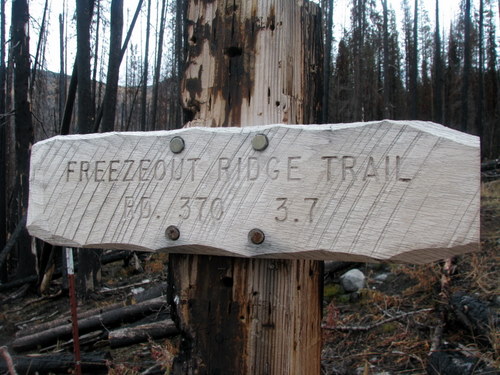 Our scouting day was spent along the Freezeout Ridge Trail near Tiffany Mountain
Our scouting day was spent along the Freezeout Ridge Trail near Tiffany Mountain
The weather is wet, with remnants of snow left over from several days before. The destination is Freezeout Pass, a low saddle at high elevation adjacent to the peak of Tiffany Mountain. As we travel up into the high country, ponderosa pines (sp. Pinus ponderosa) and aspen (Populus tremula) give way to lodgepole pine (Pinus contorta) and engelmann spruce rows (Picea engelmannii). Amidst the fog, rows of subalpine larch (Larix lyallii), a deciduous conifer that loses its needles in the fall, stand out in neon green and yellow blazes. Even these hardier trees subside, as stark evidence of the Tripod Complex fires overtake all landscape within view. Beginning in August of 2006, this fire burned over 175,000 acres, and still its presence is prominent, extending out to all horizons. New growth has since settled in though, softening the charcoaled edge, while meadow-strewn hillsides provide excellent browsing habitat for the black-tailed deer we aim to scout.
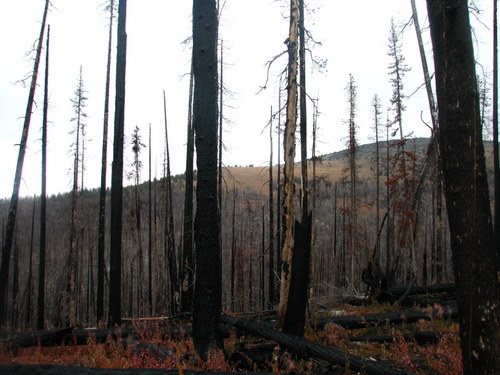 New growth of fireweed extends upward toward charcoaled snags from Tripod Fire
New growth of fireweed extends upward toward charcoaled snags from Tripod Fire
The temperature is balmy, in the low 50s. As I place an orange vest over my red-checkered wool shirt, my dad readies the rifle and explains to me some basic scouting techniques to begin with. Avoid stepping on rocks or twigs. Keep your head high. Stop every so often to check for movement. And be very quiet. This is what my students must have felt like, embodying a cougar or black bear in Camouflage. Except this is just me being me, learning to hunt and engaging with the land even deeper than before as I challenge my identity.
Deer hunting season is short for modern firearms. Run by the Washington State Department of Fish and Wildlife, season length is determined by a number of factors, including year-round studies on population dynamics by trained biologists, as well as the type of hunting equipment that is used. Those interested in partaking must take a test in order to get a permit to hunt. Bow hunting, or archery, runs for up to two weeks, beginning first in mid-September of each year. Following archery is black powder, or old mountain-man style as my Dad calls it, hunting for a week and a half, in early October. Then, lastly, modern firearms, like my dad’s hunting rifle, for one week in mid-October.
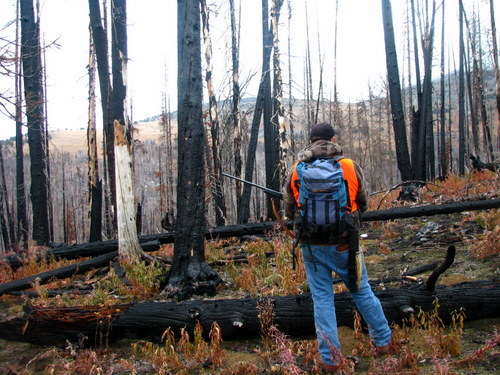 Following my Dad quietly through the open forest, while scouting for deer
Following my Dad quietly through the open forest, while scouting for deer
This year, deer season is October 17th to 25th, and with one hunting permit allowing for the taking of a single 3-point or greater buck, many might think hunting would be quick and easy to do.
Quick and easy is far from the reality. “Hunting is not a sport, it is a lifestyle,†my Dad says, as we trudge methodically up the trail, looking intently left and right. Hunting deer is ninety-nine percent observation and study — of the deer’s habitat and behavior, as well as looking for signs, like tracks and scat — while only one percent is the actual kill.
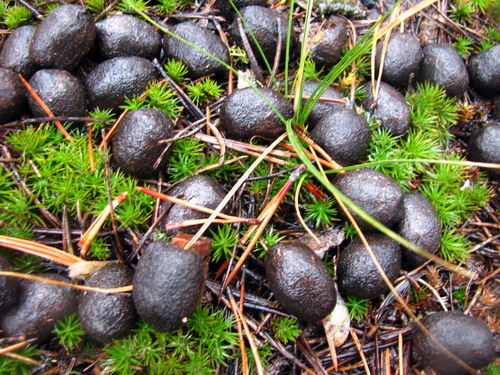 Day old deer scat are some of the signs found while scouting
Day old deer scat are some of the signs found while scouting
Oh, and I must remember patience. Most of all, hunting, just like naturalizing, like watching a fall leaf drop from above, is exercising calm and persistent patience. Without it, success is rare, and for some, success is measured by having meat on the table or going without for the year.
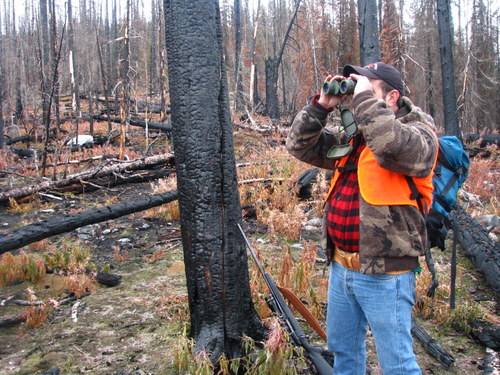 Using the binoculars to look for deer signs on the distant hills takes patience
Using the binoculars to look for deer signs on the distant hills takes patience
After an hour of scouting, the rain picks up and visibility becomes greatly reduced. I find a few day-old doe tracks and scat, while my dad spots some fresh tracks potentially coming from a buck. He points out that you can tell the age of the tracks by the sharp or duller edges that are made. The more angular the tracks are, the sooner they were imprinted.
The tracks lead to a meadow, overlooking Roger’s Lake, a perfect area for deer to be. The wind, however, has increased substantially, pushing the clouds uphill so that the rain, slanting sideways, forces us back into the protection of the few live, standing pines. Hints of Tiffany Mountain’s summit poke through the clouds, but fog is making its way up valley and causing navigation to become harder to manage. We come upon another hunter, exchange words briefly, and continue on our way.
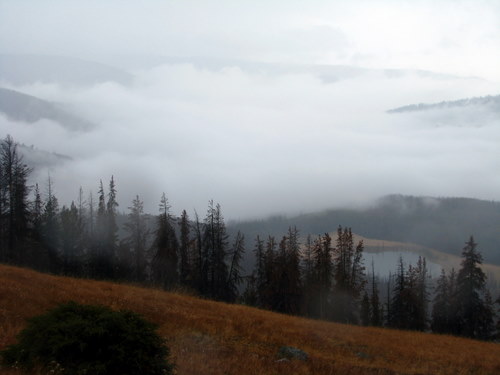 An open hillside meadow overlooking Roger’s Lake
An open hillside meadow overlooking Roger’s Lake
Fog settles into the nooks and crannies of the Okanogan Hills
Scouting for deer in the woods is no simple task. Scouting for deer in the woods with fog is near impossible. After about two hours, my orange vest is soaked from constant rain and, with visibility reduced, we decide to call it an afternoon and head toward the truck. The evening is spent at the birthplace of my outdoor spirit, Klipchuck Campground, telling stories and reading books as the cloud dissipate and reveal the unhindered eastern Washington night sky.
We wake up early the next morning. Grits for breakfast. The sun is peeking through the ponderosa pines at our site. A Stellar’s Jay calls (Cyanocitta stelleri). Old canvas tents are set up in our neighbors’ sites, chimneys in tact and fresh with wood smoke. Our destination for the morning: scouting up the Lost River Road and Harts Pass.
Along this Forest Service road, unpaved and bumpy, the terrain is beautiful and perfect for the black-tailed deer. Even at 8 in the morning, we pass by well over ten parked trucks, their passengers no doubt scouting within the complex maze of eastern pines. The road narrows as we climb in elevation and glimpses become full-on vistas of the Methow Valley extending southward in an ethereal blanket of snaking mist. Fall is even more evident in these higher reaches, where deer come to feed. Several big leaf maples trees are changing to brownish-orange. The subalpine larch becomes prominent as we near Harts Pass and Slate Peak to scout, coating hillsides in its beautiful shades, glowing.
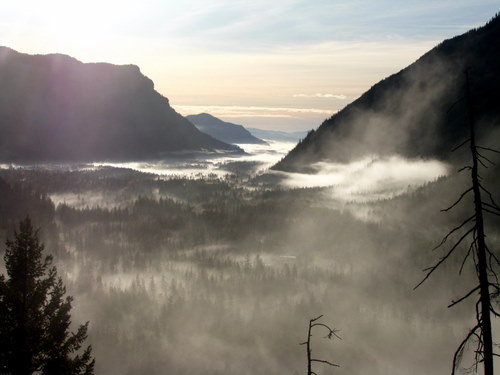 An early fall morning in the Methow Valley
An early fall morning in the Methow Valley
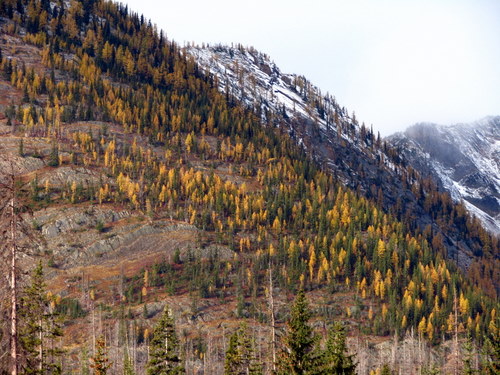 Hillsides coated in glowing larches are great indicators of the fall season
Hillsides coated in glowing larches are great indicators of the fall season
Reaching Harts Pass, the first evidence of snow appears. The road is icy and the old Harts Pass Ranger Station is boarded up. Clouds are lying low, even with the sun’s rays casting a beautiful shade of gold across the landscape. We stop to scout up a short trail leading to a ridge, but instantly become distracted by a llama trotting up the road toward us.
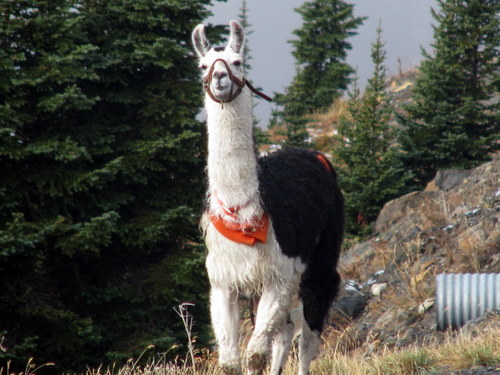 The lost llama trotting up the road on its own adventure
The lost llama trotting up the road on its own adventure
Yes, a llama. No deer scouted at this point, but a llama is walking toward us, at a pretty rapid pace no doubt. We move aside, toward the vehicle, as it trots past us, up the trail we are headed, and crests the ridge. We later find that this llama is a lost llama, whose owner has been trying to recapture it for the past four weeks. A bit of wild has returned back into it, proving it hard to catch. Dad and I scramble up the trail to the ridge crest, trying to locate it, and soon find it has trodden down another trail into yet another valley. Wild it shall remain, at least for some time more.
Looking out onto the landscape, we walk quietly and I use the techniques my Dad had pointed out the day before to assist in our scouting. We spend only a short while doing so, as both of us need to head back home that day. Though we do not find any deer, we spend some time admiring the subalpine larches up close and chuckle about the llama encounter.
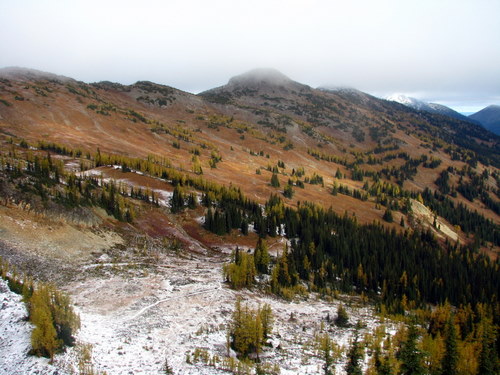 An eastward view from the ridge above Hart’s Pass
An eastward view from the ridge above Hart’s Pass
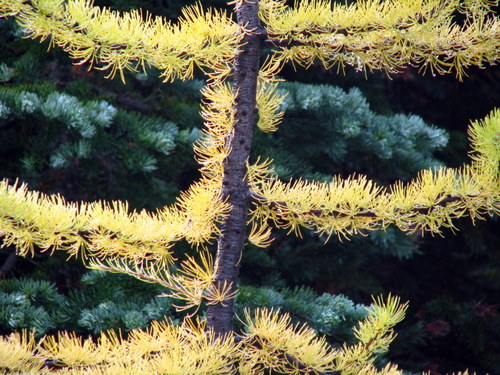 Admiring larch needles up close in the Okanogan-Wenatchee National Forest
Admiring larch needles up close in the Okanogan-Wenatchee National Forest
Some might claim that my Dad and I were unsuccessful this weekend, having only spotted one 3-point buck along the road but nowhere else and made no kills. We didn’t take in any meat this fall; that is true.
But I did take many things back with me. For one, engaging with this land in a new, different way, through hunting, has enabled me to challenge my identity and thus, become a more intimate partner in the processes that take place here. Secondly, patience. I must remember patience. There is always the next day, and even then, we might not succeed, but I exercised patience, an element so necessary in our natural world yet so often overlooked.
Of course, finally, companionship. As I grow older and come closer to finding my place in this world, it brings me so much joy knowing that I can share in the wonders of this region with those I love. Especially with my Dad, who, over 20 years ago, took me to these North Cascades and instilled, in me, the outdoor spirit that forever lingers on.
Photos courtesy of Kelsi K. Franzen.


Sounds like an excellent trip. Also any trip spent in the mountains can never be called a failure, while true you may not accomplish what you set out to do, but you’ll always leave with new experiences and memories, I’m glad you’re able to see that so clearly.
Also, on the topic of food, where it comes from and things like that, I can’t recommend the Omnivores Dilemma highly enough. Fascinating read.
Enjoyed reading this and seeing the interconnections you are experiencing with the relation to your students and Mountain School, plus your new understandings of your experience hunting with Dad. I know he enjoyed it too – even though it was short and sweet and you weren’t feeling the best. Your pictures are a treat-keep up the good work.
Hugs-Mom
So enjoyed reading this! My own experiences, following my husband, sneaking through the woods to get close to the ever elusive elk are a treasure. The smells, the sights & sounds, the excitement as even a small timber tiger is spotted! There is never failure in the appreciation of the moment. Life is full of wonder from the magic of a fall leaf turning bright red, a new baby calf being born in the dead of night or a young woman discovering herself. So Proud of you! Can’t wait to hear, see and be a part of your ever expanding experiences. I see that grin, don’t think I don’t!
Kelsi, you are an awesome “blogger”! I appreciate your dedication and contributions to Chattermarks so early on in the game. Oh, and I must say you have outlined your entire fall 2010 quarter back at Western Washington University- haha!
Katie